Learning to plant onions 3 ways offers us a diverse way to enjoy a long-lasting onion crop all year. Growing onions is made easy with this complete guide!
This post may contain affiliate links at no additional cost to you. By making your purchases through the links on this website, IMSL may make a small percentage at no direct cost to you. IMSL only promotes products we use & truly believe in. Please refer to my Privacy & Disclosures for further information. IMSL thanks you for your support!
After all, a day doesn’t pass that we don’t use at least one onion in our kitchen. With 3 options for growing onions, we certainly take advantage & plant lots in our garden each year.
If there is one crop that we plant every year & store for long-term use, it’s onions. We literally use at a minimum, one onion per day & often times more than that. Learning how to plant onions is not difficult & is something that anyone can grow, even in pots.
Why do we use so many onions you may ask? For the health benefits of course! These globes of goodness are packed with nutrients, low in calories, & high in vitamins & minerals. But that’s not all. They are filled with numerous hidden benefits as well.
HEALTH BENEFITS OF ONIONS
In addition to the above nutrition benefits, onions claim to hold anti-inflammatory properties, may benefit heart health, loaded with anti-oxidants, & even contain antibacterial properties all according to Healthline.
That not enough? Onions promote digestive health, & are easy to add to your diet in so many ways. Unfortunately, some have adverse reactions to these wonder globes.
Onion allergies may materialize for some in the form of gastric distress, red itchy eyes, & even nausea and vomiting. Fortunately, our family is able to ingest and utilize onions to their fullest here on the hill.
Before you go ahead & purchase onion seed, there are a few considerations to take note of. Location of where you will be growing your onions and determing the type of seed you will need is first and foremost.
3 “TYPES” OF ONION SEED
In order to avoid onion issues in the garden, you will need to determine which “type” of onion is best to grow in your area of the world. There are 3 types of onions, long-day, short-day, and intermediate-day. Which variety you choose to grow successfully, largely depends on your location.
SHORT-DAY ONIONS
Short-day onions are just as they sound. They are onion varieties that require at least 10-12 hours per day of daylight in order to form full sized bulbs. These varieties are wonderful for the very southern areas of the US, such as Florida & Louisiana. Should you attempt to grow short-day onions in the northern areas, you will be sadly dissappointed as the onions will develop very small bulbs and go to flower early as the daylight lengthens.
LONG-DAY ONIONS
Long-day onions require at least 14-16 hours of daylight. These varieties make wonderful options for those located in the northern tier of the USA & Canada. Should you attempt to grow long-day onions in the South, the same will hold true as the short-day onions in the north. Bulbs will not develop to their fullest, resulting in what’s referred to as “bunching” (onions grown with no bulb, green & white areas used) onions.
INTERMEDIATE-DAY ONIONS
Intermediate-day onions grow best when there is a great middle ground in daylight. Intermediate-day varieties require 12-14 hours of daylight. If you are located in the middle swath of the US, this variety would suit you well.
3 WAYS TO PLANT ONIONS
People have been planting onions for literally thousands of years and with good reason. Not only for their health benefits, but also for their unparalleled ability to store well & as an addition to any savory dish you may make.

Onions come in many sizes, shapes, & colors. By planting your own the world of these varieties really opens up. Just as there are choices in variety, so too, are there choices in how to go about planting them. Three choices to be exact.
PLANTING ONIONS FROM SEED
You can, of course, start at the very beginning, and grow your onions from seed. This method is probably the most difficult to master. Onions grown from seed will need to be planted at least 30 days PRIOR to your last frost date.
That being said, I like to plant mine MUCH earlier by winter sowing in milk jugs! I create a mini-greenhouse using milk jugs and allow Mother Nature to do the work for me! Be sure to tap the link & see my process.
In our garden zone 5b, that would mean being able to plant at the beginning of March here. As a warm weather gardener, meaning the cold is not my friend, this is just not a great option. The only successful time we planted onions from seed here on the hill was when we planted into a cold frame in the beginning of February. This process is referred to as “winter sowing”. They grew when the soil heated appropriately, did not have to be transplanted but once (aka bareroot transplants), and formed amazing bulbs to store. Now that I don’t have a cold-frame, milk jugs are used in the same way to winter sow onions from seed.
As most northern states, such as ours, does not support direct sowing of onion seeds directly into the garden, this is not an option for us. However, if you are more fortunate & able to direct sow, growing onions this way is certainly a step reducer!
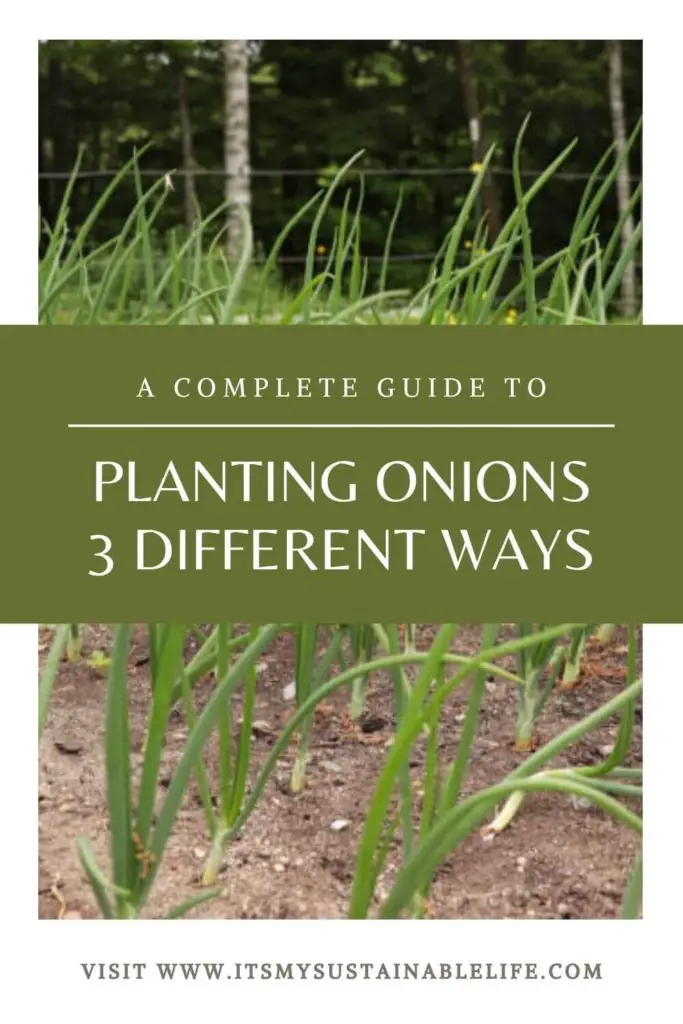
To direct sow, prepare your garden bed, draw a line in the soil approximately 1/8 to 1/4 inch deep. Sow the onions about 3 inches apart to avoid crowding & give the bulb plenty of growth space. Lightly cover the seeds & dampen the soil. As a cold weather crop, onions have no fear of a light frost.
The beauty of direct sowing your onion seeds is saving time. You plant once & your done! No transplanting required. The negative of direct sowing is getting the timing right & putting a bit of effort in their safety. They will need to be planted early enough for the onions to reach their fullest maturity by fall, & be protected from harsh weather in the spring (snows/hail). Northern climates are not great locations for direct sowing into the garden.
PLANTING ONIONS FROM SEEDS IN TRAYS
For those climates that are not conducive to direct sowing into the garden, the option of starting your onions from seed in trays is doable. With a few simple supplies & equipment, starting your own onion plants indoors will give you the head start needed to successful onion plantings.
Your options for seed starting pots or trays are wide. You can utilize any container which will give a 3-4 inch depth with drainage. For some great ideas for seed starting pots on the cheap, check out “Alternatives for DIY Seed Planting Pots On The Cheap”.
Start your seeds 10-12 weeks before transplanting dates in your area (typically between 2-4 weeks prior to your last frost date). Feel free to refer to “Seed Starting 101” for some great advice on how to grow from seeds.
If you are using cells or pots, plan on planting 2 seeds per cell & covering with 1/8 inch of soil. Should you be using the tray method, scatter your seeds & cover with 1/8 inch soil. No matter your method, once planted, dampen well. Cover with a humidity dome or plastic wrap and place in a warm area (consistent 70 F to 75 F) or on a heat mat for germination.
Once you have germination, remove the cover(s) and remove the heat mat (source) and place the onions in a cooler area, approximately 60 F to 65 F. They should receive plenty (10-12 hrs) supplemental light each day.
Once the greens have reached about 5 inches, trim them back to about 2 inches tall. This will encourage bulb growth & create a thicker, sronger onion.
Approximately 6 weeks prior to your last frost date, begin to harden off the seedlings. Hardening off simply means to expose them to natural light, reduce moisture, and acclimating them to cooler temperatures slowly over a period of time. To begin, simply place your seedlings outside for an hour or two and slowly increase the exposure over the next four weeks. Even the tender onion seedlings are very cold hardy & will tolerate a light frost.
The seedlings should now be ready to transplant into your garden space, two weeks prior to your last expected frost date. To transplant, simply create a hole using a dibble or similar tool, create a 3-4 inch deep hole, gently loosen a seedling, and drop into the hole. Gently firm the soil around the seedling leaving a bit of the green showing through the soil.
No matter your method of starting onions from seed, make sure you are using only the freshest/newest seed. Onion seed germination rates greatly reduce after one year. So start yours off with the newest seed possible for success!
PLANTING ONIONS FROM ONION SETS
Onion sets are onions that are grown from seed and forced into dormancy at an early stage. In essence, they are very tiny onion bulbs 🙂 Planting onions from sets is probably one of the easiest ways to plant your onions.
When planting from sets, plan on planting 2-4 weeks prior to your last projected frost date, and in milder climates they may be planted in fall or winter months.
For your convenience, we created a short video earlier in the spring showing how to plant onions from sets. Take a peek below & see how easy it is.
For those who prefer written directions, to plant your onion from a set, dig a small furrow, about 1 to 1.5 inches deep. Place your onion bulb (pointy end up) into the furrow, spaced about 3 inches apart. Cover with soil & water well.
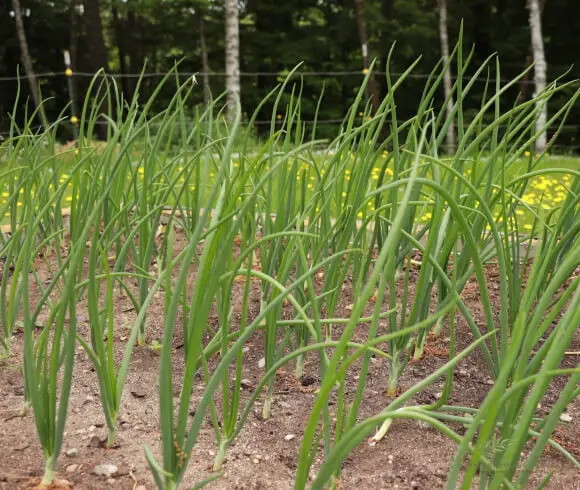
You can plant much closer together to have access to fresh green onions during the growing season by thinning in between, eventually they should be no closer together than 3-6 inches apart to allow for full bulb growth. With 3 1/2 months, the bulb will be fully developed, but as you can see from the above picture, within just over one month you can enjoy green onions.
One disadvantage of growing from onion sets is the lack of variety. Typically you will only have 3 choices, yellow, red, or white. We prefer to grow a variety named “Stuttgarter” as they are long lasting for storage purposes.
PLANTING ONIONS FROM TRANSPLANTS (BAREROOT)
Bareroot onion transplants are available to order or as stated above, you can grow your own. These transplants should be planted into the garden bed 2 weeks prior to your last projected frost date.
We have had great success planting onions from bareroot stock. It’s an easy process & reaps wonderful bulbs.
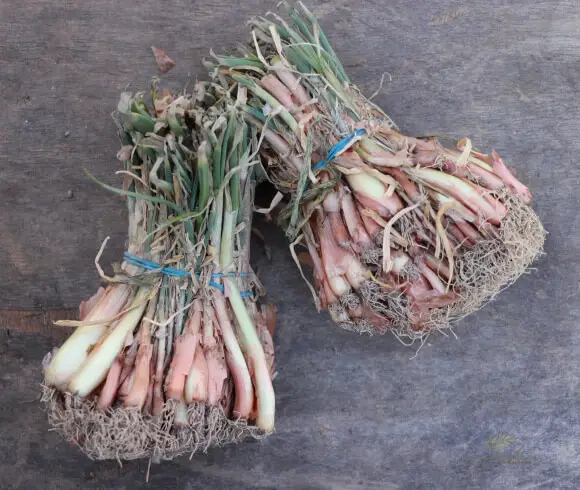
The only negative to utilizing this method is the cost if you are purchasing bundles. They can get a bit more pricey, typically about $12 to $15 per 50 plants vs. $3 to $5 for an organic seed packet to grow your own. We love to grow our summer onions, the above are a wonderful variety called “Walla Walla”, from transplants.
If your bareroot stock looks extremely dry, you can soak the bundles in a brown water mix of 1 Tbl liquid kelp to 1 gallon of water for a bit prior to planting.
To plant onions from bareroot stock, simply create a hole using a dibble or similar tool, create a 3-4 inch deep hole, gently loosen a seedling, and drop into the hole. Gently firm the soil around the seedling leaving a bit of the green showing through the soil. Water in thoroughly.
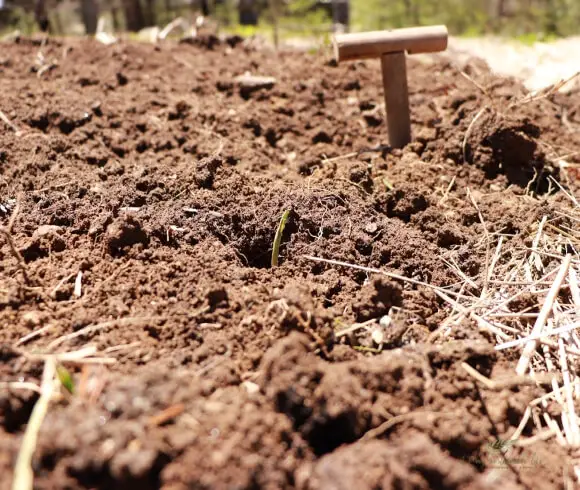
ONION GROWING TIPS
Onions grow best in loose, sandy loam that drains well. Prepare your garden well in advance by adding lots of well-aged compost & turning under at least 8 inches deep. Onions thrive in a soil pH of 6.0 to 7.5.
They are very easy to grow, but by following a few tips you can increase the size & quality of your harvest.
- Use Fresh Seed – As stated prior, use only the freshest seed you can as it will increase germination rates & reduce disease chances
- Prepare Your Garden Bed – As stated above prepare your garden bed well in advance with compost & if possible reaching a pH of 6.0 to 7.5
- Fertilize – Onions are heavy feaders and will love being fed a fish emulsion, we love to use liquid kelp, early in the season. An organic fertilizer (5-10-10) will work as well. Give a second dousing a month after the first feeding, & even side dress rows with a band of well-aged compost. When fertilizing, feed near the roots themselves as onions have very shallow root systems & will benefit from the direct feeding
- Water – Onions love water, about 1 inch per week. Letting them get dry during the early stages of growth can lead to splitting of the bulbs as they mature. Transplants may need more water than seeds or sets
- Weeding – Onions do not like to compete with weeds as their root systems are so shallow. Cultivate or gently turn the soil between the seedlings often. You may wish to consider mulching between the seedlings to reduce weed growth, making sure the mulch (& soil) stays off the top 2/3 of the onion bulb itself to encourage large bulb growth
With so many options for growing onions, & opening the world up to a wide variety of onion varieties, it’s easy to see why many grow their own. Do you already grow your own? What are your favorite varieties to grow?
Thank you for reading & as always, be sure to join our conversation(s) on all social media or by commenting below. Happy Growing!
Love, Light, & Laughter ~

Have You Seen The Latest?
- How To Sanitize Seed Trays
- How Often To Water Tomato Plants
- Winter Sowing In Milk Jugs
- How To Appliqué
- What Food Group Are Eggs In

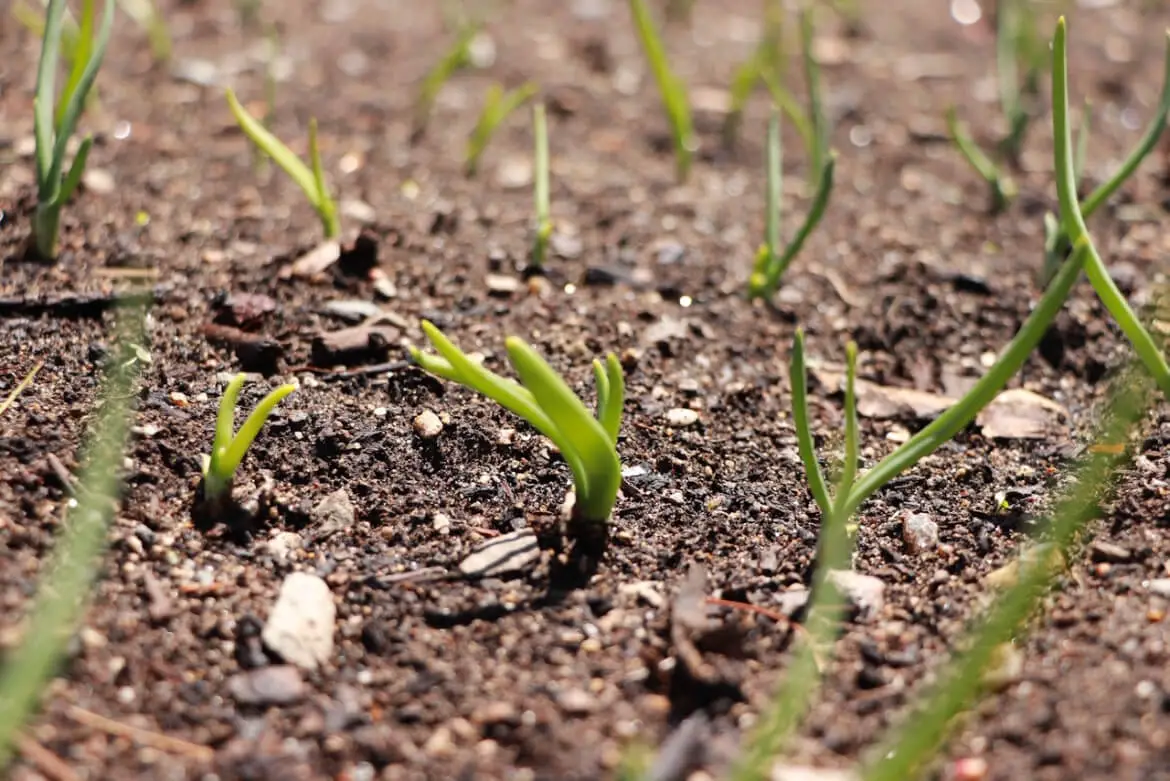

34 comments
Hey there, even though we have decided to end the link party, I still plan to do a weekly roundup post on Fridays. I am highlighting this one this week!
Thank you, Jenn! I appreciate your support!
Great tips!
Interesting article! I, however, am one of those unfortunate cases that gets pretty bad disgestive issues with onions 😞😞
Great post! I haven’t planted onions in years, but finally did this year. I can’t wait to have some fresh from the garden!
I’m not much of a gardener…I wish I was!
That’s interesting about the short, long intermediate day onions. May look into adding some to my garden in the future.
I love your posts, always so interesting and informative. We just planted cucumbers, tomato, and peppers this year. I may try onions next year.
So much good info here!
So informative! I had no idea there was short and long! Very useful!
I use so many onions! I should grow them too.
I love onions!! I have planted them in my garden with success, but haven’t done so again in a few years. I’m glad to have read your post and now know more about properly growing these vegetables. Thanks for sharing!
Wow I never knew so much went into growing onions? I would of just threw some seeds in and hoped for the best. But in Wisconsin, I’d probably need to start mine indoors I guess. Thanks for ALL this great information. I’m pinning it to my gardening board.
We’ve always purchased onion sets. We haven’t had much success with starting things from seed, so my husband prefers to buy starter plants.
I grew up weeding my mother’s massive garden. As an adult I have attempted to have my own garden. Nothing is better than growing your own vegetables and eating from the garden to the table. I wish I had more time to garden more effectively! Weeds seem to get away from me and I give up…we are not home as much as a garden requires!
We have been planting onions by seed for about a decade. We love having onions at the ready any time as they can up almost any meal with an extra something!
This is so helpful, thanks for all the details and tips! My mom grows everything, but I’m not good with any planting…but am really thinking of trying to slowly dip in and figure it out.
We are going to start planting in our new garden area and onions are something we are considering since we use them multiple times a week. We love putting them in our eggs especially omelette style. Thank you for sharing
This is an incredibly detailed discourse about planting onions! I love gardening, too. Onions are not something I have planted; first off, they’re so cheap! And, here in New Mexico, they are one of our biggest crops. (Maybe that’s why they’re so cheap here…?) Great photos and ideas; thank you.
I would love to have my own garden and plant my own onions!
These are great tips! Onions are a must grow vegetable for me- I use them almost every day!!
Great information! Very comprehensive and thorough.
Great tips about which onions to grow where. We always had a garden growing up and my dad always planted random things. I can’t recall if we had onions or not. The only things I for sure remember were corn, potatoes, pumpkins, and tomatoes.
I don’t have a green thumb but you make it seem pretty straightforward on how to grow onions. I might have to try the tray option!
Really helpful! Thanks for the tips.
I have a brown thumb, but interestingly I grew some wild onions and carrots and didn’t know it – I planted some wildflowers and they were part of the mix. I love ONIONS, but didn’t as a child.
Thank you for sharing this information, I didn’t know about the “sun” time.. this will help with which ones I can grow!
As I’m learning to cook, I am using onions often. I am learning to discern the subtle differences between the varieties of onions.
Now that our rowing season is over I plan on trying this in the fall. I was just starting to research it when I found this! Thanks for the tips!
As I mentioned before I do love Walla Walla onions. They are so sweet you can eat them like an apple. If I understand correctly the soil where they grow has a higher volcanic content and that contributes to the sweetness.
Always so interesting to link soil with flavor isn’t it? Thanks for reading, Douglas!
I have a wild onions growing in my garden. They actually have beautiful flowers but they smell bad!
I haven’t planted onions since I was a kid (with my grandma). This is the perfect guide to get me going again. Thank you!
Great information. Always super informative and love reading through how you do things. Thanks.